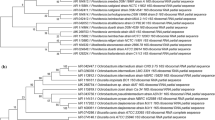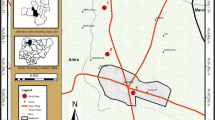Abstract
Rare earth elements (REEs) are among the common minerals in the Rare earth environment that are very precious and also enhance soil properties. The aim of this present study is to evaluate the accumulation of REEs by bacterial isolates of rare earth environment. Morphological and biochemical characterization were done for 37 bacterial isolates and also molecular studies were carried out using 16S rRNA sequencing method. The assessment of REEs composition in soil samples of Chavara and Manavalakurichi analyzed using Inductively Coupled Plasma-Mass Spectrometry (ICP-MS) showed the abundance of Cerium and Neodymium among lanthanides. The bioaccumulation study of rare earth elements by Bacillus cereus were accomplished employing FT-IR spectrum and ICP-OES analysis. The significant accumulation of rare earth elements especially Cerium and Neodymium was noticed in Bacillus cereus isolated from rare earth environment.



Similar content being viewed by others
References
Green Wood NN, Earnshan A (1984) Chemistry of the elements. Pergamon press, London, UK
Mukherjee TK (2002) Processing of Indian monazite for the recovery of thorium and uranium values. In: Ganguly C (ed) International conference on characterisation and quality control of nuclear fuels, Hyderabad, pp 187–196
Kamijo M, Suzuki T, Kawai K, Murase H (1984) Accumulation of yttrium by Variovorax paradoxus. J Ferment Bioeng 86:564–568
Andres Y, MacCordick HJ, Hubert JC (1993) Adsorption of several actinide (Th, U) and lanthanide (La, Eu, Yb) ions by Mycobacterium smegmatis. Appl Microbiol Biotechnol 39:413–417
Holt JG, Kreig NR, Sneath PHA, Staley JT, Williams ST (1994) Endospore forming Gram Positive Rods. In: Hensyl WR (ed) Bergey’s manual of determinative microbiology, 9th edn. Williams and Wilkins, Baltimore, pp 559–570
Wawer C, Muyzer G (1995) Genetic diversity of Desulfovibrio sp. in Environmental samples analysed by denaturing gradient gel electrophoresis of (NiFe) hydrogenase gene fragments. Appl Environ Microbiol 61:2203–2210
Teske A, Hinrichs KU, Edgcomb V, Gomez AV, Kysela D, Sylva SP, Sogin ML, Jannasch HW (2002) Microbial diversity of hydrothermal sediments in the Guaymas Basin: evidence for anaerobic methanotrophic communities. Appl Environ Microbiol 68:1994–2007
Altschul SF, Madden TL, Schäffer AA, Zhang J, Zhang Z, Miller W, Lipman DJ (1997) Gapped BLAST and PSI-BLAST: a new generation of Protein database search programs. Nucleic Acids Res 25:3389–3402
Larkin MA, Blackshields G, Brown NP, Chenna R, McGettigan PA, McWilliam H, Valentin F, Wallace IM, Wilm A, Lopez R, Thompson JD, Gibson TJ, Higgins DG (2007) Clustal W and Clustal X version 2.0. Bioinformatics 23:2947–2948
Kimura M (1980) A simple method for estimating evolutionary rate of base substitutions through comparative studies of nucleotide sequences. J Mol Evol 16:111–120
Tamura K, Dudley J, Nei M, Kumar S (2007) MEGA4: Molecular Evolutionary Genetics Analysis (MEGA) software version 4.0. Mol Biol Evol 24:1596–1599
Hillis DM, Bull JJ (1993) An empirical test of bootstrapping as a method for assessing confidence in phylogenetic analysis. Syst Biol 42:182–192
Date AR, Gray AL (1985) Determination of trace elements in geological samples by inductively coupled plasma source mass spectrometry. Spectrochim Acta 40B:115–122
Walsh JN, Barker J, Buckley F (1981) Simultaneous determination of the rare-earth elements in rocks using inductively coupled plasma source spectrometry. Chem Geol 33:141–153
Henderson P (1984) General geochemical properties and abundances of the rare earth elements. In: Henderson P (ed) Rare earth element geochemistry. Elsevier, Amsterdam, pp 1–32
Jeya R, Balasubramanian G, Thampi PK (2000) Determination of rare earth elements in Indian coastal monazite by ICP-AES and ICP-MS analysis and their geochemical significance. Curr Sci 94:1296–1302
Bayer ME, Bayer MH (1991) Lanthanide accumulation in the periplasmic space of Escherichia coli B. J Bacteriol 173:141–149
Andres Y, Texier AC, Cloirec PL (2003) Rare earth elements removal by microbial biosorption: a review. Environ Technol 23:1367–1375
Hirano S, Suzuki T (1996) Exposure, metabolism, and toxicity of rare earth and related compounds. Environ Health Perspect 104:85–95
DeSouza MJ, Nair S, Chandramohan D (2000) Phosphate solubilizing bacteria around Indian Peninsula. Indian J Mar Sci 29:48–51
Tsuruta T (2005) Separation of rare earth elements by microorganisms. J Nucl Radiochem Sci 6(1):81–84
Buczynski BW, Kory MM, Steiner RP, Kittinger TA, Ramsier RD (2003) Bacterial adhesion to Zirconium surfaces. Colloids Surf B 30:167–175
Ozaki T, Suzuki Y, Nankawa T, Yoshida T, Ohnuki T, Kimura T, Francis AJ (2005) Interaction of rare earth elements with bacteria and organic ligands. J Alloys Compounds 408:1329–1333
Merroun ML, Ben Chekroun K, Arias JM, Gonzalez-Munoz MT (2003) Lanthanum fixation by Myxococcus xanthus: cellular location and extra cellular polysaccharide observation. Chemosphere 52:113–120
Kazy K, Susanta K (2006) Lanthanum biosorption by a Pseudomonas sp: equilibrium studies and chemical characterization. J Ind Microbiol Biotechnol 33:773–783
Takahashi Y, Châtellier X, Hattori KH, Kato K, Fortin D (2005) Adsorption of rare earth elements onto bacterial cell walls and its implication for REE sorption onto natural microbial mats. Chem Geol 219:53–67
Author information
Authors and Affiliations
Corresponding author
Rights and permissions
About this article
Cite this article
Challaraj Emmanuel, E.S., Vignesh, V., Anandkumar, B. et al. Bioaccumulation of cerium and neodymium by Bacillus cereus isolated from rare earth environments of Chavara and Manavalakurichi, India. Indian J Microbiol 51, 488–495 (2011). https://doi.org/10.1007/s12088-011-0111-8
Received:
Accepted:
Published:
Issue Date:
DOI: https://doi.org/10.1007/s12088-011-0111-8




